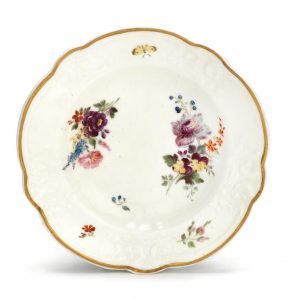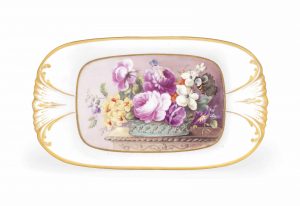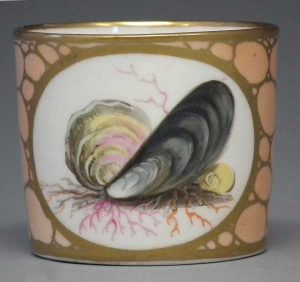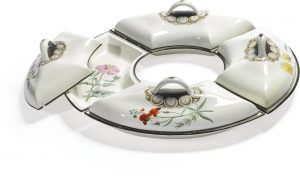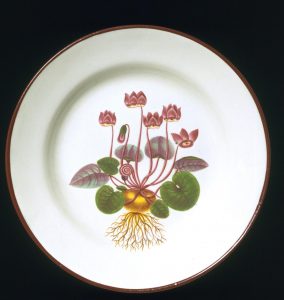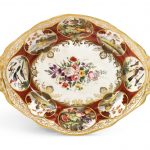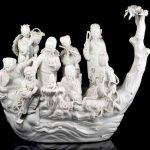Thomas Pardoe (3 July 1770 – 1823) was a British enameler noted for flower painting. He was born in Derby on 3 July 1770 and was apprenticed at the Derby (Nottingham Road) porcelain factory in the 1780s, later moving to Worcester. He painted creamware at Swansea between 1795 and 1809, coming under the influence of potter and botanist Lewis Weston Dillwyn. The following addresses are listed in the Bristol directories: Under the Bank (1809–11), 28 Bath Street (1812–16) and Thomas Street (1820–22).
In Bristol he was an independent decorator and gilder, painting china and pottery supplied in the white by John Rose of Coalport and possibly others. His Bristol pieces are the only ones he signed e.g., “Pardoe Bristol”. I assume that only the signatures that include the word “fecit” are ones he decorated, other inscriptions simply indicating retailing. According to Pountney the enamel was fired at the Temple Pottery. He also worked on glass, as the directory listing for 1813 describe him as a “China and glass enameler and gilder, wholesale and retail”. He also retailed pieces decorated at John Rose’s factory, and probably from the rival Coalport factory operated by John’s brother Thomas. Pardoe is particularly associated with botanical scenes.
He went to Nantgarw in 1821 and died in 1823. He is buried in Eglwysilan Churchyard, S.E. of Pontypridd in South Wales. His sketch book is now in the V&A Museum. In 1833 William Henry Pardoe, son of Thomas Pardoe, took over Nantgarw Pottery and began manufacturing stoneware bottles and brown glazed earthenware known as Rockingham pottery. He also began manufacturing clay tobacco pipes, many of which were exported to Ireland. The business continued under Pardoe’s descendants, and at its peak produced around 10,000 pipes a week, until its closure in 1920, when cigarettes replaced such clay pipes. Wikipedia
A Nantgarw shallow bowl, circa 1818-20 With C-scroll moulding, painted at the factory by Thomas Pardoe with two sprays of flowers, scattered sprigs and a yellow insect in flight, the rim picked out in gold, 20.6cm diam, impressed NANT-GARW CW
Sold for £ 937 inc. premium at Bonhams in 2018
A NANTGARW SHAPED-OVAL DISH CIRCA 1821-23 With gilt shell-moulded handles, painted by Thomas Pardoe, with luxuriant pink roses and other garden flowers issuing from a basket on a table, within gilt line cartouche (minor wear to gilding) 10 7/8 in. (27.7 cm.) wide
Sold for GBP 6,875 at Christies in 2012
Coalport coffee can circa 1815 painted in Bristol by Thomas Pardoe with shells within a peach ground, 5.5cm high Condition report: No damage or restoration. Small amounts of gilt wear.
Sold for £280 at Peter Wilson Fine Art Auctioneers in 2014
A Swansea pearlware part supper service circa 1805 each crescent-shaped dish and cover painted, by Thomas Pardoe, with a named flower specimen, both dishes and covers impressed SWANSEA and incised with the letter C and various numerals. 8 pieces. length 13 5/8 in. 34.6 cm
Sold for 1,000 USD at Sothebys in 2014
Creamware plate, earthenware painted with enamels. Decorated with a flowering plant, its leaves, bulb and root. The edge is brown.
By about 1800 mass-produced creamware had become almost white. This responded to changing fashions. In turn, it proved to be a perfect ground for delicate enamel painting. These thinly potted dessert plates were made at Swansea in south Wales. They show faithful reproductions of botanical specimens copied from contemporary engravings. They were probably intended primarily for display.
ca. 1800 (made)
Reference: © Victoria and Albert Museum
